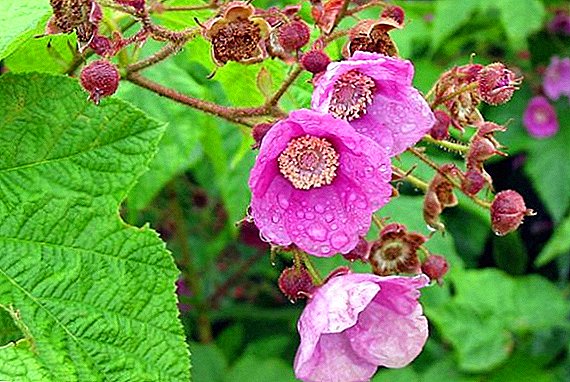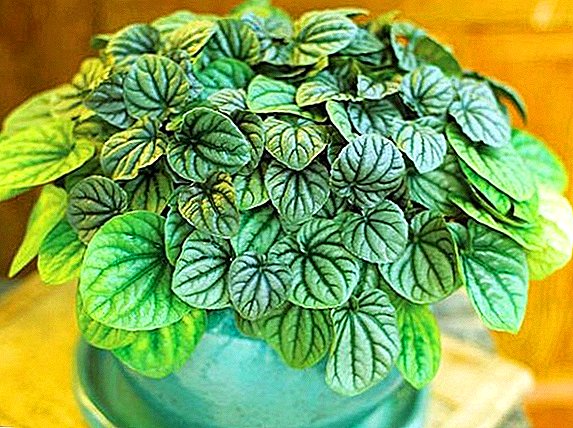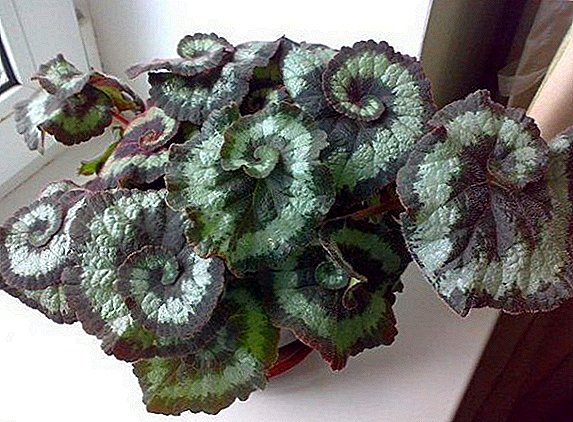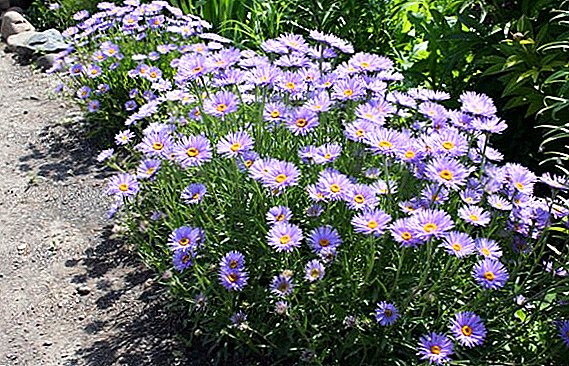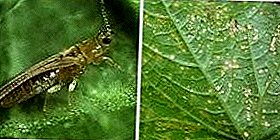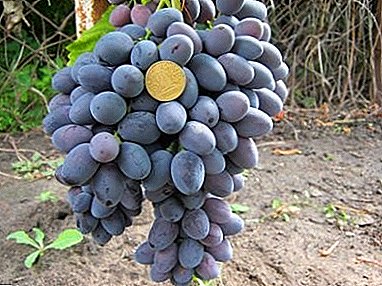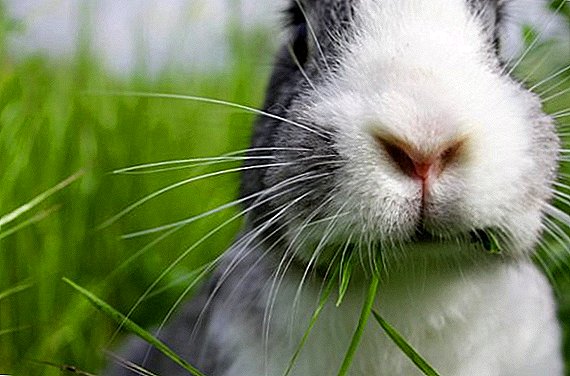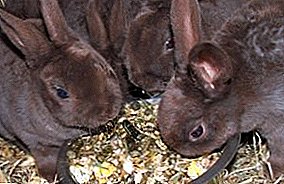 Silo is one of the most common feedings for various types of agricultural and ornamental animals. It gives the opportunity to saturate the body with all sorts of vitamins and minerals, as well as a huge amount of nutrients, which is quite important in the off-season and winter season. However, this type of feed often does not have direct recommendations for consumption, so many farmers use this product with caution, especially in the diet of domestic rabbits. Today we will look at the main benefits of using silage for growing rabbits, as well as learn how to properly prepare this product yourself.
Silo is one of the most common feedings for various types of agricultural and ornamental animals. It gives the opportunity to saturate the body with all sorts of vitamins and minerals, as well as a huge amount of nutrients, which is quite important in the off-season and winter season. However, this type of feed often does not have direct recommendations for consumption, so many farmers use this product with caution, especially in the diet of domestic rabbits. Today we will look at the main benefits of using silage for growing rabbits, as well as learn how to properly prepare this product yourself.
Is it possible to give corn silage to rabbits
Silo is a juicy concentrated animal feed, which is obtained by fermenting the green mass of various cultivated plants or herbs under anaerobic conditions (without direct access of atmospheric air). For raising rabbits often use corn silage. This type of food has a high nutritional value and great nutritional value for the body of rabbits, which is especially important for the northern regions during the long absence of fresh green food.  This feed helps the fur-bearing animals to compensate for the deficiency of vitamins and other nutrients. Their absence during the off-season can cause deterioration of immunity and overall growth rates of rabbit production. That is why silage is not only necessary, but also vital food for the body of rabbits, regardless of the breed.
This feed helps the fur-bearing animals to compensate for the deficiency of vitamins and other nutrients. Their absence during the off-season can cause deterioration of immunity and overall growth rates of rabbit production. That is why silage is not only necessary, but also vital food for the body of rabbits, regardless of the breed.
Did you know? Siloing, as a method of preserving feed, was first used in the XVIII century in Sweden and the Baltic.
The main benefits of silage feedings for the body of rabbits:
- improve digestion and gastrointestinal function;
- increase the overall immunity;
- increase the fertility of animals;
- help increase the digestibility of other types of feed;
- contribute to the set of body weight and improve the quality of animal products;
- accelerate the metabolism and growth rate of young.
Silage Feeding Rules
Despite the safety, high value and nutritional value for the body, silage feed should be introduced into the animal ration following certain rules. First of all, such a product is a derivative of fermentation, which is why abrupt substitution of vegetables for silage can cause quite negative health effects, including severe diarrhea and weight loss. Next, we consider the basic rules for introducing the product into the diet of domestic rabbits. 
How to enter into the diet
Enter silage as feed gradually. The period of use of top dressing falls on a cold season - from late autumn to early spring. At this time, free access to all sorts of vegetables, fruits and green herbs is sharply reduced. Therefore, along with vegetable feed, silage should be introduced smoothly. The first portions of food should be given small, mixed with bran or other dry food. If for several days the silage does not cause disorders of the gastrointestinal tract in an animal, then the amount of feed is gradually increased.
Important! At the time of feeding, the product should be subject to full fermentation, since the immature silage may adversely affect the health of rabbits.
Scheme of silage in the diet of rabbits:
- the first 1-2 days a portion of silage should not exceed 1-2% of the total mass of food;
- starting from 2-4 days, the portion is increased to 2-5%;
- from day 5 of use, the portion is increased to 5-10% of the total mass of the feed;
- after a week of use, silage feed can replace up to 40-50% of all juicy food.
How and how much can be given
Silage can be used both in pure form and in the form of various nutrient mixtures not based on dry feed. Traditionally, the most preferred is the use of mixtures based on dry food. Such food is absorbed more efficiently than individually, and also helps to improve the further susceptibility of the gastrointestinal tract to roughage. 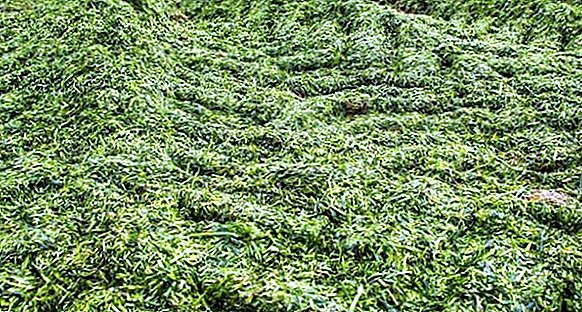 Use this dressing no more than 2 times a day, morning and evening. The maximum amount of feeding should fall on the evening feeding, so no more than 1/3 of the daily norm is used in the morning. It is not recommended to give silage on an empty stomach, as it may irritate the external integuments of the stomach and intestines. Best of all, if such dressing will go after a small portion of root crops or other vegetables. In their absence, silage can be given after feed or other complex feed.
Use this dressing no more than 2 times a day, morning and evening. The maximum amount of feeding should fall on the evening feeding, so no more than 1/3 of the daily norm is used in the morning. It is not recommended to give silage on an empty stomach, as it may irritate the external integuments of the stomach and intestines. Best of all, if such dressing will go after a small portion of root crops or other vegetables. In their absence, silage can be given after feed or other complex feed.
After each portion of the feeder must be carefully cleaned of residues. Silage is a medium with a high content of anaerobic bacterial mass, with free access of oxygen, these bacteria begin to break down food debris and release a variety of toxic substances. As a result, the feeder becomes contaminated with toxicants that can harm the delicate body of fur-bearing animals.
Learn all about feeding rabbits.
The rate of pure silage for feeding adults:
- adult average males and females - no more than 300 g / day;
- suckling females - about 350-400 g / day;
- females during lactation - no more than 500-600 g / day;

Young silage can be given no earlier than one month after birth. In this case, this feeding must be introduced with extreme caution, since the body of the rabbit does not always respond correctly to highly concentrated nutrient mixtures. Therefore, before transferring to full-fledged adult nutrition, no more than 50 g of silage per day is shown to the little rabbits. Starting with 2-3 months of life, the rabbits become adults completely, from which time the volume of silage dressings can be smoothly increased to 300 g of pure product per day.
How to make silage for rabbits at home
Today, to acquire high-quality silage is not a problem. This type of feed is quite widely represented on the market, so you can buy it in almost any large store for farm animals. However, when maintaining an active farm, silage becomes one of the ways to utilize all sorts of residues of cultivated plants with benefit. Therefore, many farmers resort to the independent production of the product, but not everyone succeeds in obtaining high-quality and safe silage. Next, we consider the basic principles of ensilage of cultivated plants at home.
Did you know? In Australia, rabbits are considered a dangerous pest. Mass reproduction of these animals in the early twentieth century led to the death of many rare species of native animals.
Silage crops
Traditionally, silage is used for all kinds of litter consisting of the green mass of valuable plant crops. Among them are found both tops of fruit crops, and specially grown green mass, consisting of all sorts of green herbs of leguminous crops, as well as from sprouts of fruit plants. Any remains of the aerial parts of plants actively used in food for rabbits are suitable for ensiling, but not all plants produce a truly high-quality product.  Often this is due to the individual characteristics of the plants, which, during their active growing season, are able to accumulate in the green mass all kinds of compounds that adversely affect the fermentation. As a result, bacterial silage cultures cannot be fully processed by green mass. In the final result, this leads to decay of plant residues, and in some cases to poor-quality or completely unsuitable product.
Often this is due to the individual characteristics of the plants, which, during their active growing season, are able to accumulate in the green mass all kinds of compounds that adversely affect the fermentation. As a result, bacterial silage cultures cannot be fully processed by green mass. In the final result, this leads to decay of plant residues, and in some cases to poor-quality or completely unsuitable product.
Which are well ensiled
The following cultivated plants are the most suitable for high-quality silage of green mass:
- corn;
- sorghum;
- Dzhugara;
- ground pear;
- sunflower;
- watermelon;
- beet;
- pumpkin;
- cabbage;
- peas;
- Sudanese;
- Sudanese;
- yellow lupine (alkaloid-free).

For silage also use the roots of the following plants:
- potatoes;
- swede;
- turnip;
- carrot;
- beet.
What are bad
Due to the low content of sugars in the green mass poorly silage:
- tributary;
- Vika;
- potato tops;
- sedges;
- alfalfa;
- clover afterburner;
- panic;
- Prutnyak;
- quinoa;
- sagebrush.

The plants are completely non-splitting:
- mustard;
- rank;
- bitter lupine;
- soy.
Important! The plant and the fruits of tomatoes are strictly prohibited for ensiling. This plant contains compounds that are toxic to rabbits, which can cause serious disturbances in the work of his body, even death.
How to grind (chop)
Proper cutting of raw materials for silage is one of the main conditions for obtaining a quality product, since an excessively large mass negatively affects the overall silage process. It is best if the plant residues are crushed as small as possible, but sufficient sizes are:
- 3-4 cm - for plants with a thin stem (legumes, clover, meadow grasses, etc.);
- 5-6 cm - for plants with a rough stem (corn, sunflower, etc.).
 Sometimes many farmers face the problem of excessive watery raw materials. This often occurs during the harvesting of young plants in the phase of active growth, since at this stage the young shoots actively accumulate water and all sorts of nutrients from the soil. To prevent the loss of valuable moisture and important vitamins, raw materials are recommended to be diluted with finely chopped straw or hay.
Sometimes many farmers face the problem of excessive watery raw materials. This often occurs during the harvesting of young plants in the phase of active growth, since at this stage the young shoots actively accumulate water and all sorts of nutrients from the soil. To prevent the loss of valuable moisture and important vitamins, raw materials are recommended to be diluted with finely chopped straw or hay.How to lay a silo
After preparation of the raw material, it is necessary to lay it in silage tanks. Today, many structures are used for these purposes (hermetic barrels, buckets with a lid, centralized structures, etc.), but the most common is patching. For this purpose, special pit-banks are equipped in the soil, in which the fermentation of raw materials is carried out.
Did you know? Rabbits are one of the most fearful animals on the planet, a sharp and loud noise can lead to cardiac arrest in this animal.The pit is often prepared by 10-15% more than the total volume of the harvested raw materials, since the cut grass should be protected from cold weather, atmospheric and groundwater with insulating materials. To do this, the bottom of the pit is covered with plastic film, over which dry straw is laid about 15-20 cm thick. If the silo pit is placed in a stationary place, its bottom and walls can be laid out with bricks or reinforced concrete slabs.
 To improve the quality of the silo, prior to laying the raw materials, the pit is disinfected. For this, a special smoke bomb made of sulfur is ignited and thrown into it. You can buy a sulfur checker in almost any hardware store.
To improve the quality of the silo, prior to laying the raw materials, the pit is disinfected. For this, a special smoke bomb made of sulfur is ignited and thrown into it. You can buy a sulfur checker in almost any hardware store.Siloing is an anaerobic process, therefore it is necessary to create tightness conditions for the raw materials in the pit. To do this, plant residues are carefully tamped and stacked on top of the straw (about 10-20 cm thick), and then with a layer of clean soil at least 15 cm thick. To improve the tightness of the pit, it is recommended to lay a thick plastic film over the straw.
Read more about how to properly prepare the silo and store it.
Through how much silage is ready for use
Often ensiling is a fairly long process. With a well-equipped pit, fermentation is completed in 2-3 months. In order to speed up ensiling up to 1.5-2 months, a special ferment is added to the raw materials, consisting of highly active antagonistic bacteria strains with increased productivity. However, if you do not have additional funds for the purchase of leaven, you can speed up the process of obtaining the product by introducing natural pastes into the raw materials (10% of the total mass). For these purposes, suitable viscous suspension of flour or potato starch.
Important! Before feeding rabbits with fresh silage, the product should be checked for quality. Properly prepared silage will have a light, pleasant herbal smell, without any rotten or unpleasant impurities.
Flour Kleister is prepared as follows:
- In a clean container, tap water and wheat flour or potato starch (optional) are mixed at a rate of 1: 3.
- The resulting mixture is put on medium heat and bring to a boil, stirring occasionally.
- After boiling the liquid is removed from the heat, cooled and passed through a fine sieve or gauze.

Silo is a valuable product, without which it is difficult to imagine modern animal husbandry. Entering into the diet of such feed makes it possible to increase the quality as well as the quantity of animal products. At present, silage is prepared from virtually any green mass of cultivated plants, but traditionally corn silage is traditionally considered to be the most qualitative and beneficial for rabbits. Only it contains the maximum number of various nutrients, as well as can improve the work of the gastrointestinal tract.


